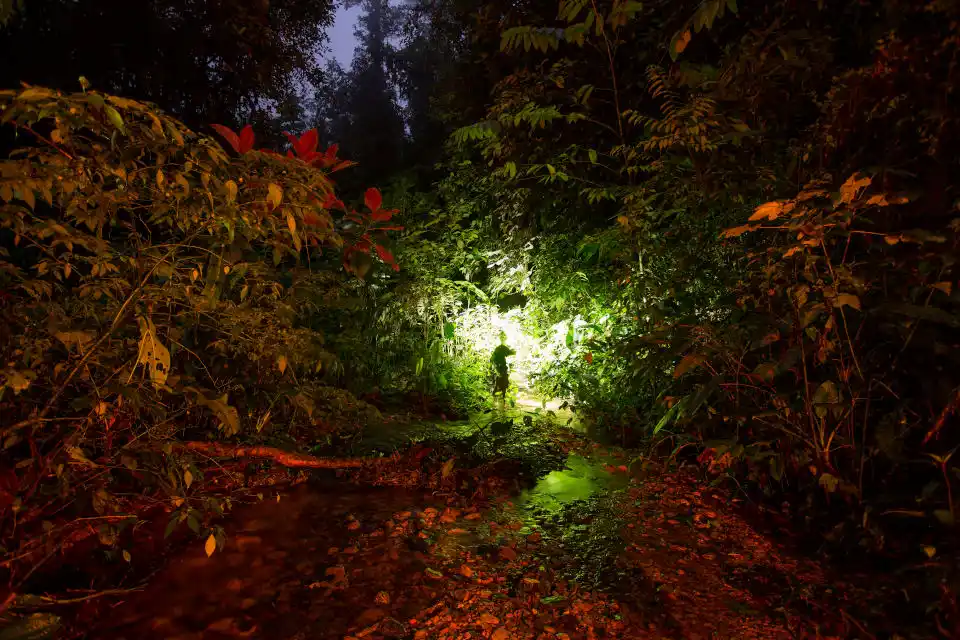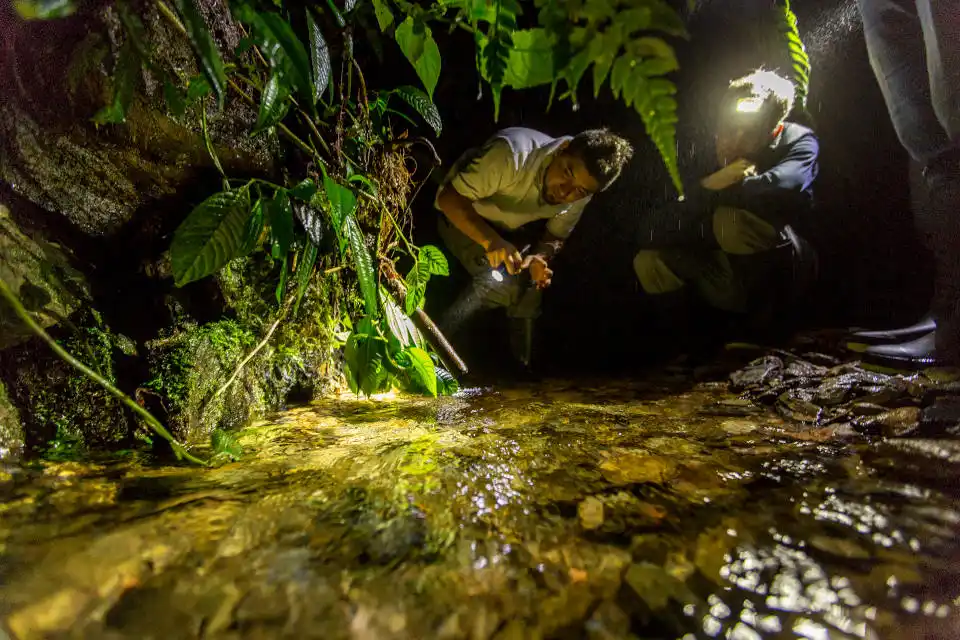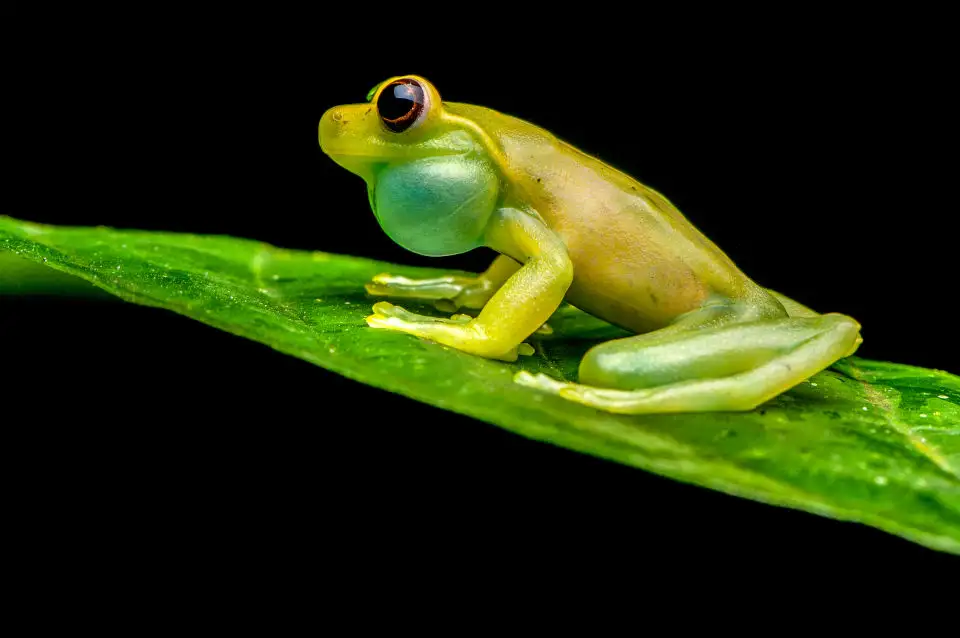Miniscule and elusive, nearly perfectly camouflaged with its surroundings, the Mashpi Torrenteer Frog (Hyloscirtus mashpi), often referred to simply as the Mashpi Frog, is a relatively recently-discovered species of tree frog in the world, which had hitherto been unknown to the science community. It is one of the Mashpi Reserve’s greatest sources of pride. In this blog, we invite you to discover what makes this frog so special and just how, exactly, it was identified as an entirely new species of frog.
How and where was the Mashpi Torrenteer Frog discovered?
Carlos Morochz, the former Resident Biologist and Research Director of Mashpi (who just recently became Expedition Manager and Director of Investigation), is the man behind this extraordinary discovery. Having lived in the Mashpi forest as part of his initial research endeavors (quite sometime before the Lodge itself was even built), Carlos makes this patch of Earth a highly unique place to call home. In many ways, one could say he knows the forest like the back of his hand at this point… but then again, there are always new and exciting things that surprise him, such as the Mashpi Torrenteer Frog.

He first came upon the unique species of amphibian back in 2011, recalling the fact that he immediately “sensed that it was something different.” Upon following up with an amphibian-focused foundation in Quito (the capital of Ecuador that’s just a few hours away from Mashpi), he was advised to embark on a more detailed study of the frog.
How was it identified as a new species?
In order to verify that it was a new species, Carlos knew he would need to get knee-deep into its morphology, behavior, and population.
As a result, Carlos and his team of resident biologists began monitoring streams throughout the Mashpi Reserve, taking numerous photos of individual frogs that helped them examine, in greater detail, the color variation that existed across the different species of frogs. They also became highly attuned to the differences between their calls as they began to record them.
Carlos and his team even managed to collect blood samples to aid them in a more in-depth examination of the genetic and molecular variation between the species that lived within the Reserve. It was after a long period of diligent studies that Carlos, his team, and the help of the aforementioned foundation in Quito, that they came to confirm that this truly was a new species of frog. As such, it eventually came to be named the “Mashpi Torrenteer,” with its scientific name being “Hyloscirtus mashpi.”

All of their collected data, along with its distinct size, color (a noticeable black stripe on its back), and unique calls made it clear that this species was indeed new to science, making this a new member to the already-diverse list of fascinating wildlife that can be found in the region and Mashpi Reserve.
The discovery eventually came to be published in the Neotropical Biodiversity Journal in August of 2015, an achievement which still stands as a source of great pride for the Mashpi family. It has also helped greatly boost research and conservation efforts in the incredibly rich forests of Mashpi.

What sets it apart from the rest of the frogs out there?
The Mashpi Torrenteer Frog is often found along streams and bodies of water, giving away its position by means of its call (which it often tends to make at nightfall). It has a year-round reproductive cycle, with its habitat centered in the Equatorial Choco (principally within Ecuadorian territory), making it an endemic species of Mashpi.
The Mashpi Torrenteer Frogs are highly similar to the species of frog known as H. alytolylax, with only two morphological traits that help differentiate the two: H. mashpi has a smaller body size and has a dorsum that frequently reveals a mid-dorsal stripe. H. mashpi also has a shorter call that contains 2 or 3 notes, while H. alytolylax has a longer call that can range between 5 and 8 notes. H. mashpi is found at lower elevations (between 778 and 1,279 m.a.s.l. / 2,552 – 4,196 f.a.s.l.) when compared to H. alytolylax (which is typically found between (1,510 and 1,858 m.a.s.l. / 4,954 – 6,095 f.a.s.l.).
Where are Mashpi Torrenteer Frogs found? Do they have any unique adaptations?
Having been discovered along the western slopes of the Ecuadorian Andes in the province of Pichincha (which is just a stone’s throw away from the capital city of Quito), the Mashpi Torrenteer frog is a nocturnal species that mainly resides close to rivers or riverbanks. It is often found perching on leaves or branches just a few centimeters above the ground and/or stream surface level. It appears to reproduce opportunistically throughout the whole year.

At the nearby Torrenteer Lagoon (which is within short walking distance of Mashpi Lodge itself), guests can find tadpoles in abundance in many of the flatter areas of this visitor site that have high levels of water accumulation. It is within these areas that Mashpi Torrenteer tadpoles are found hanging out on leaves or searching the rocky, underwater bottom for food.
The Mashpi Torrenteer frogs also have a gland on the chin that was suspected (and then later confirmed) to be a part of the male’s courtship for the female.




